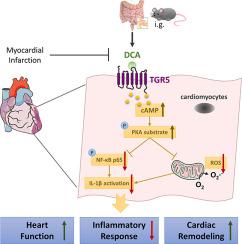Journal of Molecular and Cellular Cardiology ( IF 4.9 ) Pub Date : 2020-10-31 , DOI: 10.1016/j.yjmcc.2020.10.014 Jiaxing Wang 1 , Jianshu Zhang 1 , Xianjuan Lin 1 , Yupeng Wang 1 , Xiang Wu 2 , Fan Yang 2 , Wei Gao 1 , Yan Zhang 3 , Jinpeng Sun 4 , Changtao Jiang 5 , Ming Xu 6

|
Aims
The progression of myocardial infarction (MI) involves multiple metabolic disorders. Bile acid metabolites have been increasingly recognized as pleiotropic signaling molecules that regulate multiple cardiovascular functions. G protein-coupled bile acid receptor (TGR5) is one of the receptors sensing bile acids to mediate their biological functions. In this study, we aimed to elucidate the effects of bile acids-TGR5 signaling pathways in myocardial infarction (MI).
Methods and results
Blood samples of AMI patients or control subjects were collected and plasma was used for bile acid metabolism analysis. We discovered that bile acid levels were altered and deoxycholic acid (DCA) was substantially reduced in the plasma of AMI patients. Mice underwent either the LAD ligation model of MI or sham operation. Both MI and sham mice were gavaged with 10 mg/kg/d DCA or vehicle control since 3-day before the operation. Cardiac function was assessed by ultrasound echocardiography, infarct area was evaluated by TTC staining and Masson trichrome staining. Administration of DCA improved cardiac function and reduced ischemic injury at the 7th-day post-MI. The effects of DCA were dependent on binding to its receptor TGR5. Tgr5−/− mice underwent the same MI model. Cardiac function deteriorated and infarct size was increased at the 7th-day post-MI, which were not savaged by DCA administration. Moreover, DCA inhibited interleukin (IL)-1β expression in the infarcted hearts, and ameliorated IL-1β activation at 1-day post-MI. DCA inhibited NF-κB signaling and further IL-1β expression in cultured neonatal mouse cardiomyocytes under hypoxia as well as cardio-fibroblasts with the treatment of LPS.
Conclusions
DCA-TGR5 signaling pathway activation decreases inflammation and ameliorates heart function post-infarction. Strategies that control bile acid metabolism and TGR5 signaling to ameliorate the inflammatory responses may provide beneficial effects in patients with myocardial infarction.
中文翻译:

DCA-TGR5信号激活减轻心肌梗死的炎症反应并改善心功能
目标
心肌梗塞(MI)的进展涉及多种代谢紊乱。胆汁酸代谢物越来越被认为是调节多种心血管功能的多效性信号分子。 G蛋白偶联胆汁酸受体(TGR5)是感受胆汁酸以介导其生物学功能的受体之一。在本研究中,我们旨在阐明胆汁酸-TGR5 信号通路在心肌梗死 (MI) 中的作用。
方法和结果
收集 AMI 患者或对照受试者的血样,并使用血浆进行胆汁酸代谢分析。我们发现 AMI 患者血浆中胆汁酸水平发生改变,脱氧胆酸 (DCA) 显着减少。小鼠接受 MI 的 LAD 结扎模型或假手术。 MI 和假手术小鼠从手术前 3 天开始灌胃 10 mg/kg/d DCA 或载体对照。通过超声心动图评估心功能,通过TTC染色和Masson三色染色评估梗死面积。心肌梗死后第 7 天,使用 DCA 可改善心脏功能并减少缺血性损伤。 DCA 的作用取决于与其受体 TGR5 的结合。 Tgr5 - / -小鼠接受相同的 MI 模型。心肌梗塞后第 7 天,心脏功能恶化,梗塞面积增加,但 DCA 给药并未破坏这些情况。此外,DCA 抑制梗塞心脏中白细胞介素 (IL)-1β 的表达,并改善 MI 后 1 天的 IL-1β 激活。 DCA 抑制缺氧条件下培养的新生小鼠心肌细胞以及经 LPS 处理的心肌成纤维细胞中的 NF-κB 信号传导并进一步抑制 IL-1β 的表达。
结论
DCA-TGR5 信号通路激活可减少炎症并改善梗塞后的心脏功能。控制胆汁酸代谢和 TGR5 信号传导以改善炎症反应的策略可能会对心肌梗死患者产生有益的影响。









































 京公网安备 11010802027423号
京公网安备 11010802027423号